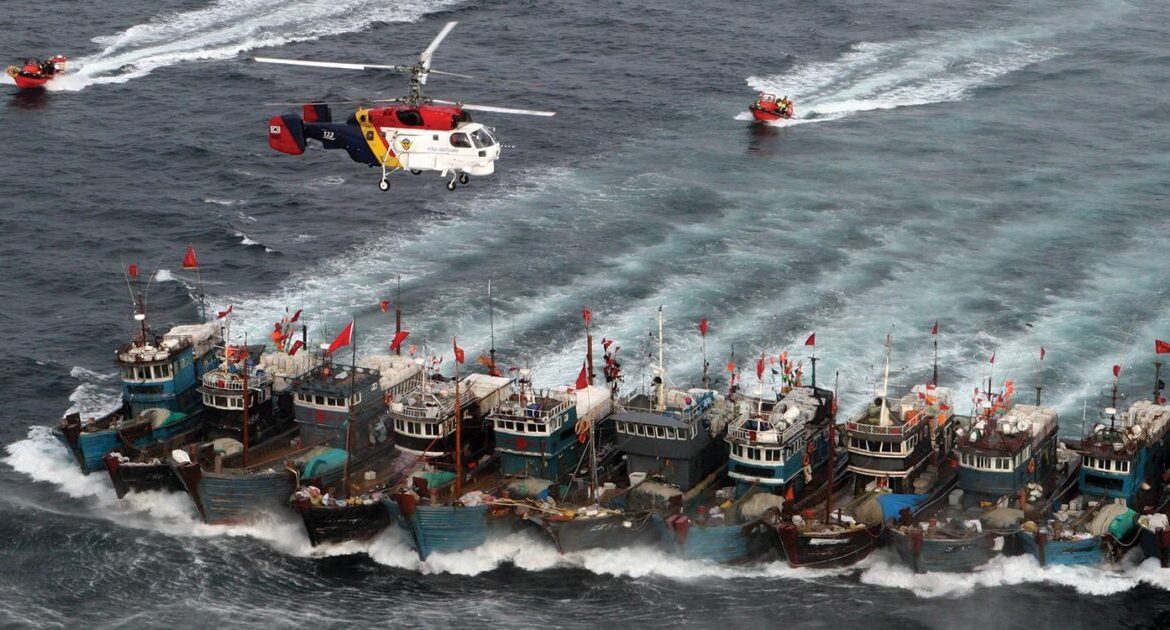
China’s Wooden Fleet – Maritime Militia and Distant Water Fishing Boats, Grey Zone Warriors


China possesses the world’s largest fishing fleet, and its vast flotilla serves a dual purpose of commercial activity and carrying out the political objectives of the Chinese Communist Party. At the center of this system is the People’s Armed Forces Maritime Militia (PAFMM), a force that operates behind a civilian facade while carrying out intelligence collection, reconnaissance, coercive presence missions, and direct support to naval operations.
The militia functions as an auxiliary arm of the PLA Navy and the China Coast Guard but remains legally categorized as a civilian fleet. This ambiguity enables Beijing to conduct gray-zone operations with reduced accountability while raising the risk of miscalculation and escalation.
China draws its militia vessels from both a professional fleet and a much larger pool of fishing boats based in Hainan and Guangdong. These ships operate under government subsidies and crews are made up of civilian fishermen, sailors, and former military personnel.
Many vessels remain idle at contested sites because the government payments exceed profits from fishing. Satellite imagery and state media confirm that these operations are coordinated and purposeful, even as Beijing continues to portray them as ordinary fishing activity.
Militia vessels have played central roles in confrontations with the Philippines, Vietnam, and Japan, helping China seize or consolidate positions at Mischief Reef, Scarborough Shoal, and other disputed features. Swarming, rafting, and long-term anchoring are used to intimidate rival claimants and secure claims without firing a shot. These actions have been condemned globally as violations of international law. Regional pushback has grown, yet China continues to expand these operations.
The scale of China’s fishing and militia fleets is difficult to determine. Government figures put the number of distant-water vessels at roughly 2,700, while external estimates range from 6,500 to over 16,000, depending on methodology. Broader counts of all Chinese-flagged fishing vessels exceed 50,000. At the high end, some assessments suggest that as many as 200,000 vessels could be mobilized in a crisis. Regardless of the exact figure, the fleet’s size, civilian appearance, and tendency to operate without transponders make it extremely difficult to monitor. Even with satellite imagery, the number and dispersion of vessels make comprehensive surveillance nearly impossible.
The militia monitors foreign naval movements and collects intelligence in regions where Beijing avoids deploying warships, taking advantage of its civilian cover. Satellite evidence shows a shift toward anchoring at fortified Chinese outposts, signaling that Beijing no longer sees value in maintaining the illusion that these vessels are simply fishermen.
Swarming and blockading remain core tools. At Sabina Shoal in 2024, more than two hundred militia vessels appeared in a single week. At Second Thomas Shoal, militia and coast guard ships escalated their obstruction of Philippine resupply missions. These tactics follow the cabbage strategy described by PLA Maj. Gen. Zhang Zhaozhong, in which layers of fishing boats, coast guard vessels, and warships encircle a feature to expand control without triggering a military response.
Militia forces also participate in China Coast Guard drills, particularly during periods of cross-strait tension, rehearsing inspection and expulsion operations to pressure Taipei. Their reach has expanded beyond the South China Sea into the Pacific and toward Africa, where they monitor foreign navies and advance Chinese interests while retaining civilian protection.
In wartime, China intends to use the maritime militia as a core component of its assault planning for Taiwan. Civilian vessels would provide a significant portion of the logistical lift needed to move troops, vehicles, and supplies across the strait. PLA planning documents and U.S. naval analyses show that mobilized militia ships would sustain naval forces at sea and ground forces ashore.
Tasks could include transporting troops, embarking special operations teams, rescuing downed pilots, shadowing Chinese warships to confuse enemy targeting, enforcing blockades, and laying or sweeping mines. Civilian tankers and cargo ships can be outfitted for alongside replenishment, carry fuel and ammunition, support helicopter resupply, and provide emergency services such as towing, repair, and firefighting.
Some militia crews would augment PLA Navy personnel to replace casualties aboard warships. Beijing has built a shadow navy of ferries, roll-on roll-off ships, and deck carriers that can be mobilized rapidly, representing the largest potential civilian sealift effort in modern history.
Xi Jinping’s national rejuvenation agenda underpins this maritime strategy. The CCP seeks to remake China as the dominant global power, a goal tied to protecting sovereignty and reclaiming territories such as Taiwan and Hong Kong. Maritime control is central to that ambition.
Marine resources, trade routes, and offshore claims are treated as both economic lifelines and sovereign rights. These priorities have pushed China toward a system in which maritime law enforcement agencies and the maritime militia operate on the front lines during peacetime, while the PLA Navy remains in a supporting role. Their activities challenge U.S. interests by asserting control over international waters and by attempting to restrict foreign military activity inside China’s claimed exclusive economic zone.
In wartime, the roles would reverse, with the PLA Navy taking the lead and the maritime militia supporting combat operations. Article 36 of China’s Military Service Law reinforces the militia’s wartime role, assigning it responsibilities that include preparing for war, defending frontiers, maintaining public order, and standing ready to join the armed forces whenever required. The militia’s quasi-official status as a military or paramilitary force raises serious questions about whether the United States and its allies should treat Chinese fishing vessels as military ships
The post China’s Wooden Fleet – Maritime Militia and Distant Water Fishing Boats, Grey Zone Warriors appeared first on The Gateway Pundit.
